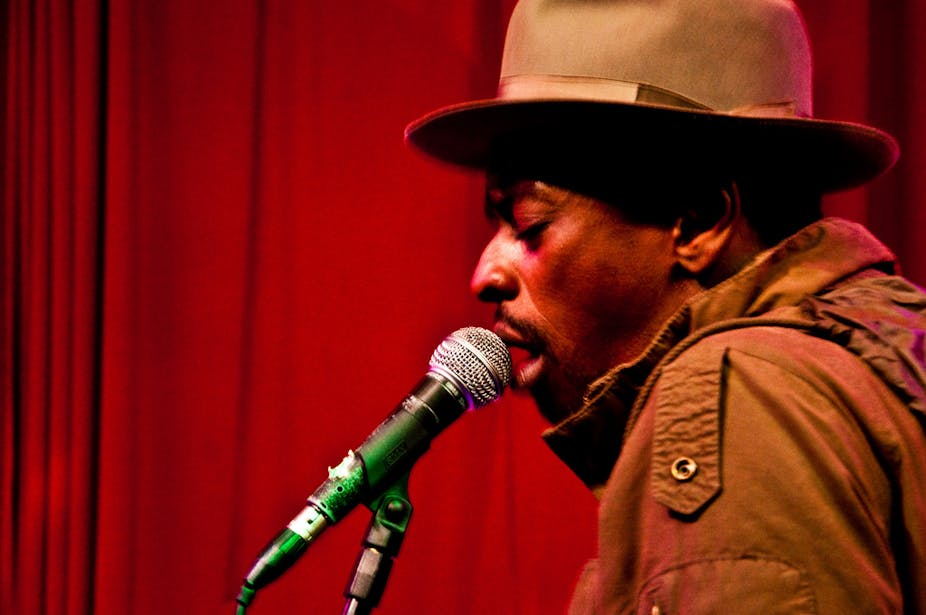One evening ten years ago I was walking in pouring rain down the streets of Cidade Baixa in downtown Porto Alegre, Brazil. I went into a music store to look around and, to my surprise, the two-storey building had dedicated the first floor to “international” music – and the whole ground floor was filled with Brazilian music. The store stocked as much Brazilian music as recordings of all genres, eras and tastes from the rest of the world.
Perhaps I shouldn’t have been surprised – Brazil is the ninth-largest phonographic market in the world, according to the most recent IFPI report, and a country where the live music market is valued at some US$5.5 billion. The record label Som Livre, for example, is the country’s largest independent record label, producing over 100 Brazilian artists and competing with major labels such as Sony and Universal for market share.
The loud song playing on that quiet evening in the store was Eu Sou Favela (I Am Favela), performed by the recently deceased Bezerra Da Silva, a musician who inspired many contemporary Brazilian artists – including Seu Jorge, who grew up in one of these favelas in Rio.
On that day in Porto Alegre, I knew only of Seu Jorge from his early hit Carolina (2001) and his performance as the charming crook Mané Galinha in the film City of God (2002). Directed by Fernando Meirelles, it tells the intricate story of a decade-long gang war that breaks out in a favela of Rio de Janeiro.
So one of the CDs I bought was the The Life Aquatic Studio Sessions Featuring Seu Jorge, a collection of David Bowie songs recorded by Seu Jorge in Portuguese for the soundtrack to Wes Anderson’s comedy hit The Life Aquatic with Steve Zissou (2004) in which Seu Jorge played the character of Pelé dos Santos.
Ten years on, the rain was falling again last weekend when Seu Jorge performed at the Sydney Festival. This was the Australian debut of a man who is now a hugely popular and internationally renowned artist.

The story of bossa nova, the Brazilian music that seduced the world in the 1960s, is well known. Less known to Australian audiences is the contemporary Brazilian music scene in which different genres such as hip-hop, pop, reggae and samba merge quite seamlessly, creating unmistakable Brazilian sounds and beats. At the forefront of a renaissance of Brazilian pop-samba - and its commercial success - is Seu Jorge.
When he took to the stage on Sunday, the 4000-capacity theatre was not quite full – but there was an upbeat feeling of expectation from a predominantly Brazilian crowd of largely middle-class Brazilian students and young professionals. While the Brazilian community in Sydney is still comparatively small, the show was a reminder that the Brazilian community migrating to Australia is growing in numbers and visibility, and of the cultural contribution it makes to cosmopolitan Sydney.
Music is often a practice of citizenship in Brazil and now it is often possible to see how this is practised in Manly, Bondi or Coogee, where a large proportion of newly arrived and transient Brazilians live.
The Sydney Festival show was no different. The crowd danced and sang along with every song Seu Jorge played. It was as much a demonstration of how Brazilians in Sydney use their cultural identity in a strategic way to work out their integration in a cosmopolitan Sydney, as a demonstration of the diversity within Brazilian society and its complex and rich history of immigration.
Seu Jorge devoted the first part of the two-hour concert to showcase some of his well-known hits. These bring together Latin-jazz, samba and pop. Some of his songs have a slightly outdated 1990s sound but still Seu Jorge (on flute and acoustic guitar) and his band of five musicians (electric guitar, bass and two keyboards) led the crowd through one dance track after another.
Then came the acoustic interlude. The band retired backstage, Seu Jorge took off his leather jacket and sunglasses and began a medley of hits. The encore had everyone dancing again, all the way to the last song, Seu Jorge’s first and perhaps biggest hit, Carolina.
At the end, the inevitable confession that every contemporary Latin American musician makes when playing in Sydney: “It never occurred to me I would be playing in Australia,” said Seu Jorge, as he farewelled an adoring audience. Visibly grateful for the response and the good vibe of the night, he promised to return with the rest of his musicians.
Seu Jorge played at the Sydney Festival on January 11. Details here.

